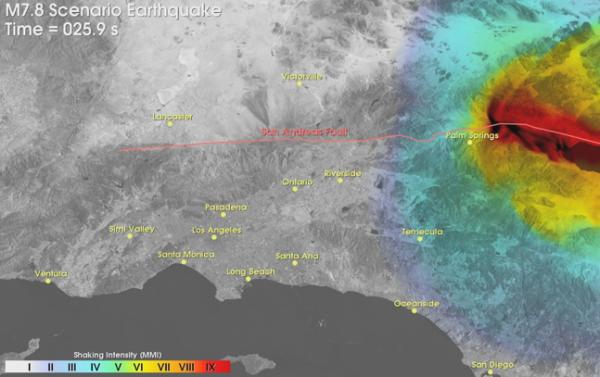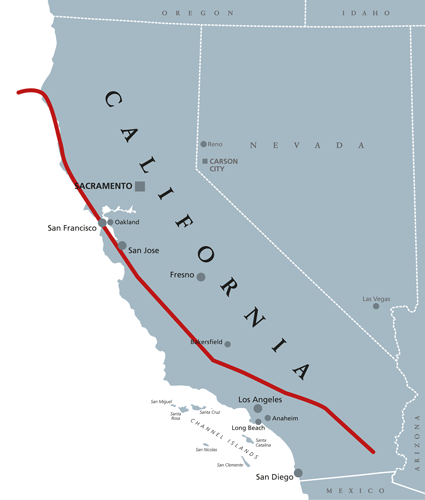The Notorious San Andreas Fault: A Geological Giant Shaping California
When we think of the next big earthquake, we think of the San Andreas fault. The San Andreas fault line formed about 30 million years ago as the North American plate engulfed nearly all of the Farallon plate. Since then, the North American plate has ground against the Pacific plate at a boundary called a strike-slip fault.
This fault is one of the largest faults in the world, running more than 800 miles from the Salton Sea to Cape Mendocino. It carves the state in two. San Diego, Los Angeles and Big Sur are on the Pacific Plate. San Francisco, Sacramento and the Sierra Nevada are on the North American Plate. The two plates crisscross with dozens of active and passive earthquake faults.
See Your Local Earthquake Risk
San Andreas fault line map
The San Andreas runs deep near and under some of California’s most populated areas. The cities of Desert Hot Springs, San Bernardino, Wrightwood, Palmdale, Gorman, Frazier Park, Daly City, Point Reyes Station and Bodega Bay rest on the San Andreas fault line.
The Southern San Andreas slices through Los Angeles County along the north side of the San Gabriel Mountains. It can cause powerful earthquakes—as big as magnitude 8—that would affect high population communities in SoCal.
What type of fault is the San Andreas?
A San Andreas earthquake would be classified as occurring on a strike-slip fault. Strike-slip faults are found along boundaries of tectonic plates sliding past each other.
Understanding the San Andreas: A Strike-Slip Fault in Motion
A strike-slip fault is a vertical fracture in the earth’s crust that creates horizontal motion, along the line of the fault. The walls of rock move to the left relative to one another, or to the right relative to one another. These faults are formed by horizontal compression.
- Motion along a strike-slip fault is horizontal.
- Shear stress is acting on the opposing earthen blocks.
- The fault surface is near vertical.
- Stress on the San Andreas fault causes right-lateral motion
What would be the Impact of a major earthquake on the San Andreas Fault?
USGS scenarios project more than 1,800 deaths, and 50,000 injuries due to a major Southern San Andreas fault earthquake. CoreLogic, a business analysis service, estimated a Southern San Andreas fault rupture will cause 3.5 million homes to be at risk with $289 billion in reconstruction value.
Twelve years ago, seismologists modeled how the ground would shake on the southern San Andreas fault. Engineers and social scientists used that information to estimate the effects of a hypothetical 7.8 quake that strikes the Coachella Valley.
- The earthquake waves travel across the whole state of California, leveling older buildings, disrupting roads and severing electric, telephone and water lines.
- Hundreds of fires start.
- Emergency personnel are hampered with the roads out.
- Water, electricity and gas lines cross the San Andreas fault in Los Angeles. They break during the quake and remain unfixed for months.
- Many retrofitted homes and newer buildings survive the shaking, but many older homes are rendered structurally unusable.
Video of the Southern San Andreas Earthquake Scenario

Southern San Andreas Earthquake Scenario
This portion of the San Andreas fault has been identified as the most likely source of a very large earthquake in California. In this computer simulation constructed through a collaborative effort between the United States Geological Survey and the Southern California Earthquake Center, the magnitude 7.8 scenario earthquake ruptures 186 miles from Bombay Beach at the edge of the Salton Sea in the south to Lake Hughes northwest of Palmdale in the north.
Is your house near the San Andreas fault?
Scientists project the San Andreas fault line could cause a devastating earthquake in California by 2030. This fault has caused some of the biggest earthquakes in California with a magnitude.
Most of California’s population lives and works on the west side of the fault.
Do you live near the San Andreas fault? Or near the network of 500 active California faults that feed into it?
Keep in mind the fault is always moving about 2 inches a year. Find out about your home’s earthquake risk with CEA’s earthquake fault map by county.
How to prepare for an earthquake
While the San Andreas Fault Zone is the most studied in the world, nothing can prevent a major earthquake from happening. The key to being safe during an earthquake is preparation. While an earthquake safety kit will be of help after an earthquake, nothing replaces the conversations you have with your family members before an earthquake.
Create an earthquake safety plan for you and loved ones.
- Be sure to identify safe places in each room of your home.
- Practice Drop, Cover, and Hold On with each member of your household.
- Make or purchase an earthquake safety kit. Make sure to have water and snacks available in each room of your home.
- Check out affordable California earthquake insurance.
Consider a seismic retrofit, which involves strengthening your home’s foundation to make it more resistant to shaking. CEA offers earthquake home insurance premium discounts for houses and mobilehomes that have been retrofitted. Find out about grants to help for retrofits under the Earthquake Brace & Bolt program, and the CEA Brace & Bolt program.
Understanding Structural Risks to your House
Learn about the potential geologic structural threats to your home in case of a major earthquake. The violent shaking from earthquakes can:
- Rupture the earth.
- Trigger landslides.
- Turn loosely packed, water-saturated soil to liquid.
If your home was built before 1980, it may also be vulnerable to serious structural damage. With safety planning, reinforcing the outside of home and your personal property, and earthquake insurance, you stand a better chance of riding out the next San Andreas rupture.
Evaluating Geologic Hazards Near Your House
Find out about the primary geologic hazards where you live could affect your home during an earthquake.
Your earthquake hazard and risk depends on the location of your home, your home’s construction, and your home’s location near the active fault zone such as the San Andreas Fault Zone. Other factors to consider include:
- The population density in your community.
- Building codes.
- Your family’s emergency preparedness.
Personal Preparedness Guidelines
Prepare your home BEFORE an earthquake. Decrease your risk of San Andreas earthquake damage and injury from an earthquake by identifying possible home hazards:
- Tall, heavy furniture that could topple, such as bookcases, china cabinets, or modular wall units.
- Water heaters that are not up to code by being strapped could rupture.
- Stoves and appliances that could move enough to rupture gas or electrical lines.
- Hanging plants in heavy pots that could swing free of hooks.
- Heavy picture frames or mirrors over a bed.
- Latches on kitchen cabinets or other cabinets that will not hold the door closed during shaking.
- Breakables or heavy objects that are kept on high or open shelves.
- A masonry chimney that could crumble and fall through an unsupported roof.
- Flammable liquids, such as painting or cleaning products, which would be safer in a garage or an outside shed.
Is earthquake insurance worth it?
What if a devastating San Andreas earthquake hits your home and community?
- Major earthquakes can cause extensive damage to the foundation, siding and roof of homes. Older homes built before 1980 on a raised foundation are especially vulnerable if they are not retrofitted.
- Without residential earthquake insurance, you will be responsible for all repair and/or rebuilding costs.
- Government disaster assistance, if available, may only come in the form of a small grant or capped loan, which may cover only a portion of your repair costs and may need to be repaid.
- Without Loss of Use earthquake coverage—which includes covering your additional expenses of living elsewhere due to earthquake damage to your home—you’d still be paying your mortgage plus temporary housing rent during the time repairs are underway.
CEA’s affordable earthquake insurance policies let you select the coverage that fits your budget. Our insurance rates, based on the latest science and research, are determined by several factors including your home’s age, location near a fault, foundation type, construction type, and roof type.
Discover the peace of mind—before the next San Andreas earthquake strikes—that comes with the smart financial decision to buy California earthquake insurance.
Get an earthquake insurance estimate!
Don’t be caught unprepared when, not if, the next San Andreas earthquake hits California! Get an earthquake insurance estimate by using the CEA premium calculator.
Contact your insurance agent today to discuss policy options. CEA works with the majority of California insurance companies. You don’t have to wait for your home policy renewal to sign up.
Get Your Earthquake Insurance Estimate
Sources Consulted:
- USGS: The San Andreas Fault
- CalTech: San Andreas Fault Zone
- Corelogic: Southern California San Andreas Fault Rupture Cost
- Southern California Earthquake Center: San Andreas Fault Rupture Scenarios
- Los Angeles Times: What would a powerful earthquake feel like where you live
- LiveScience: San Andreas Earthquake Facts

